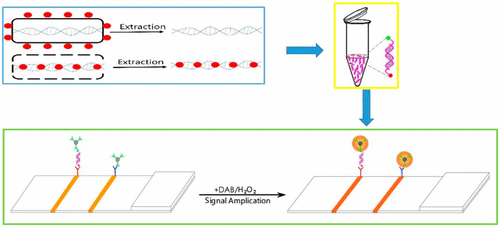当前位置:
X-MOL 学术
›
Anal. Chem.
›
论文详情
Our official English website, www.x-mol.net, welcomes your
feedback! (Note: you will need to create a separate account there.)
Ultrasensitive Detection of Viable Enterobacter sakazakii by a Continual Cascade Nanozyme Biosensor
Analytical Chemistry ( IF 6.7 ) Pub Date : 2017-09-20 00:00:00 , DOI: 10.1021/acs.analchem.7b01266 Li Zhang 1 , Yuting Chen 2 , Nan Cheng 1 , Yuancong Xu 1 , Kunlun Huang 1, 2, 3 , Yunbo Luo 1, 2 , Peixia Wang 4 , Demin Duan 4 , Wentao Xu 1, 2, 3
Analytical Chemistry ( IF 6.7 ) Pub Date : 2017-09-20 00:00:00 , DOI: 10.1021/acs.analchem.7b01266 Li Zhang 1 , Yuting Chen 2 , Nan Cheng 1 , Yuancong Xu 1 , Kunlun Huang 1, 2, 3 , Yunbo Luo 1, 2 , Peixia Wang 4 , Demin Duan 4 , Wentao Xu 1, 2, 3
Affiliation

|
Recent outbreaks of life-threatening neonatal infections linked to Enterobacter sakazakii (ES) heightened the need to develop rapid and ultrasensitive detection strategies, especially those capable of determining the viable cells. This study introduced a continual cascade nanozyme biosensor for the detection of viable ES based on propidium monoazide (PMA), loop-mediated isothermal amplification (LAMP), and Nanozyme strip. The ompA gene of ES was determined using FITC-modified and BIO-modified primers in the LAMP process. LAMP combined with PMA treatment was applied for distinguishing the viable from the dead state of ES. Then, using Fe3O4 magnetic nanoparticles as a nanozyme probe, a magnetic nanoparticle (MNP)-based immunochromatographic strip (Nanozyme strip) was further employed for amplifying signal to allow visual detection and quantification by a strip reader. The LAMP products were sandwiched between the anti-FITC and the anti-BIO, and the accumulation of the Fe3O4 magnetic nanoparticles enabled the visual detection of ES. The detection limit of the nanozyme biosensor was improved by 10 CFU/mL compared with previously reported techniques, and the whole manipulation process was much faster (within 1 h) and simpler (without specialist facilities). Hence, the developed continual cascade nanozyme biosensor has provided a rapid, ultrasensitive, and simple tool for on-site detection of viable ES.
中文翻译:

连续级联纳米酶生物传感器对阪崎肠杆菌的超灵敏检测。
最近与阪崎肠杆菌(ES)相关的威胁生命的新生儿感染暴发,使人们更加需要开发快速和超灵敏的检测策略,尤其是那些能够确定活细胞的检测策略。这项研究介绍了一种连续级联纳米酶生物传感器,用于检测基于单叠氮化丙锭(PMA),环介导的等温扩增(LAMP)和纳米酶试纸条的可行ES。在LAMP过程中使用FITC修饰的引物和BIO修饰的引物确定ES的omp A基因。LAMP结合PMA治疗可以区分ES的生存状态和死亡状态。然后,使用Fe 3 O 4磁性纳米颗粒作为纳米酶探针,还使用了基于磁性纳米颗粒(MNP)的免疫色谱带(Nanozyme strip)来放大信号,从而可以通过条带读取器进行视觉检测和定量。LAMP产品被夹在抗FITC和抗BIO之间,并且Fe 3 O 4磁性纳米粒子的积累使ES的视觉检测成为可能。。与以前报道的技术相比,纳米酶生物传感器的检出限提高了10 CFU / mL,并且整个操作过程更快(在1小时内)并且更简单(在没有专业机构的情况下)。因此,开发的连续级联纳米酶生物传感器已经为现场检测存活的ES提供了快速,超灵敏和简单的工具。
更新日期:2017-09-20
中文翻译:

连续级联纳米酶生物传感器对阪崎肠杆菌的超灵敏检测。
最近与阪崎肠杆菌(ES)相关的威胁生命的新生儿感染暴发,使人们更加需要开发快速和超灵敏的检测策略,尤其是那些能够确定活细胞的检测策略。这项研究介绍了一种连续级联纳米酶生物传感器,用于检测基于单叠氮化丙锭(PMA),环介导的等温扩增(LAMP)和纳米酶试纸条的可行ES。在LAMP过程中使用FITC修饰的引物和BIO修饰的引物确定ES的omp A基因。LAMP结合PMA治疗可以区分ES的生存状态和死亡状态。然后,使用Fe 3 O 4磁性纳米颗粒作为纳米酶探针,还使用了基于磁性纳米颗粒(MNP)的免疫色谱带(Nanozyme strip)来放大信号,从而可以通过条带读取器进行视觉检测和定量。LAMP产品被夹在抗FITC和抗BIO之间,并且Fe 3 O 4磁性纳米粒子的积累使ES的视觉检测成为可能。。与以前报道的技术相比,纳米酶生物传感器的检出限提高了10 CFU / mL,并且整个操作过程更快(在1小时内)并且更简单(在没有专业机构的情况下)。因此,开发的连续级联纳米酶生物传感器已经为现场检测存活的ES提供了快速,超灵敏和简单的工具。











































 京公网安备 11010802027423号
京公网安备 11010802027423号